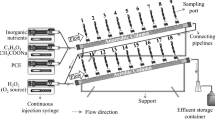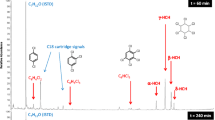Abstract.
The potential for biodegrading of mono-, di- and trichlorobenzenes in a contaminated aquifer in Bitterfeld (Saxony-Anhalt) was tested both in the laboratory and using on-site column experiments. Under the prevailing anaerobic conditions, the reductive dechlorination of 1,4-dichlorobenzene (1,4-DCB) takes place very slowly. Under aerobic conditions the indigenous micro-organisms are able to mineralize monochlorobenzene (MCB) and 1,4-DCB. The degradation rates for the other two isomeric dichlorobenzenes and for 1,2,4-trichlorobenzene (1,2,4-TCB) under aerobic conditions are significantly lower. Indications were found that once the oxygen has been consumed, Fe(III) species can be used as alternative electron acceptors.
Similar content being viewed by others
Author information
Authors and Affiliations
Additional information
Electronic Publication
Rights and permissions
About this article
Cite this article
Dermietzel, J., Vieth, A. Chloroaromatics in groundwater: chances of bioremediation. Env Geol 41, 683–689 (2002). https://doi.org/10.1007/s00254-001-0451-5
Received:
Accepted:
Issue Date:
DOI: https://doi.org/10.1007/s00254-001-0451-5




